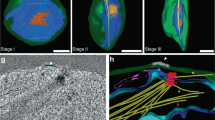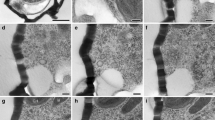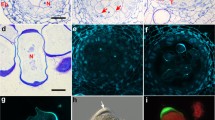Abstract
This is the first report on the organization of a quadripolar microtubule system (QMS) in polyplastidic meiosis of a hepatic with polar organizers (POs). Unlike the monoplastidic sporocytes of mosses and hornworts, in which meiotic quadripolarity can be traced to plastid division and migration, sporocytes of Aneura pinguis are polyplastidic and tetrahedrally lobed before the QMS is organized. Whereas the QMS in mosses and hornworts is plastid-based, the QMS of A. pinguis is focused at four POs where gamma tubulin (γ-tubulin) is concentrated. An aster of microtubules emanates from each PO centered in the four cytoplasmic lobes and the opposing radial microtubules interact to form the QMS that envelops the nucleus. A functionally bipolar spindle is gradually formed as the four poles converge in pairs on either side of opposite cleavage furrows. The resulting spindle remains quadripolar. Although γ-tubulin is most concentrated in the deeply concave poles straddling cleavage furrows, it also extends into the spindle itself. Telophase groups of chromosomes curve around the polar cleavage furrows and a phragmoplast that originates in the interzonal region guides a cell plate that extends to the equatorial cleavage furrows. Discrete POs are reformed at opposite tips of the elongated dyad nuclei in prophase II and microtubules radiating from them give rise to the spindles of second meiosis. Spindles remain sharply focused and γ-tubulin extends into distal portions of the spindle. Interzonal phragmoplasts that expand to join with pre-established cleavage furrows mediate cytokinesis resulting in a tetrad of spores. Each young tetrad member has a radial microtubule system emanating from the nucleus.


Similar content being viewed by others
References
Apostolakos P, Galatis B (1985) Studies on the development of the air pores and air chambers of Marchantia paleacea. III. Microtubule organization in preprophase-prophase initial aperture cells—formation of incomplete preprophase microtubule bands. Protoplasma 128:120–135
Brown RC, Lemmon BE (1988a) Cytokinesis occurs at boundaries of domains delimited by nuclear based microtubules in sporocytes of Conocephalum conicum (Bryophyta). Cell Motil Cytoskeleton 11:139–146
Brown RC, Lemmon BE (1988b) Sporogenesis in bryophytes. Adv Bryol 3:159–223
Brown RC, Lemmon BE (1990) Polar organizers mark division axis prior to preprophase band formation in mitosis of the hepatic Reboulia hemisphaerica (Bryophyta). Protoplasma 156:74–81
Brown RC, Lemmon BE (1992) Polar organizers in monoplastidic mitosis of hepatics (Bryophyta). Cell Motil Cytoskeleton 22:72–77
Brown RC, Lemmon BE (1993) Diversity of cell division in simple land plants holds clues to evolution of the mitotic and cytokinetic apparatus in higher plants. Mem Torrey Bot Club 25:45–62
Brown RC, Lemmon BE (1995) Methods in plant immunolight microscopy. Methods Cell Biol 49:85–107
Brown RC, Lemmon BE (1997) The quadripolar microtubule system in lower land plants. J Plant Res 110:93–106
Brown RC, Lemmon BE, Horio T (2004) γ-Tubulin localization changes from discrete polar organizers to anastral spindles and phragmoplasts in mitosis of Marchantia polymorpha L. Protoplasma (in press)
Duckett JG, Ligrone R (1995) The formation of catenate foliar gemmae and the origin of oil bodies in the liverwort Odontoschisma denudatum (Mart.) Dum. (Jungermanniales): a light and electron microscope study. Ann Bot 76:405–419
Farmer JB (1895) On spore-formation and nuclear division in the Hepaticae. Ann Bot 9:469–523
Fowke LC, Pickett-Heaps JD (1978) Electron microscope study of vegetative cell division in two species of Marchantia. Can J Bot 56:467–475
Horner HT, Lersten NR, Bowen CC (1966) Spore development in the liverwort Riccardia pinguis. Am J Bot 53:1048–1064
Horio T, Basaki A, Takeoka A, Yamato M (1999) Lethal level overexpression of γ-tubulin in fission yeast causes mitotic arrest. Cell Motil Cytoskeleton 44:284–295
Nguyen H, Brown RC, Lemmon BE (2001) Patterns of cytoskeletal organization reflect distinct developmental domains in endosperm of Coronopus didymus (Brassicaceae). Int J Plant Sci 162:1–14
Renzaglia KS, Brown RC, Lemmon BE, Duckett JG, Ligrone R (1994) Occurrence and phylogenetic significance of monoplastidic meiosis in liverworts. Can J Bot 72:65–72
Schuster RM (1984) Evolution, phylogeny and classification of the Hepaticae. In: Schuster RM (ed) New manual of bryology, vol. 2. Hattori Botanical Laboratory, Nichinan, Japan, pp 892–1070
Shimamura M, Deguchi H, Mineyuki Y (1998) Meiotic cytokinetic apparatus in the formation of the linear spore tetrads of Conocephalum japonicum (Bryophyta). Planta 206:604–610
Shimamura M, Mineyuki Y, Deguchi H (2000) Monoplastidic meiosis in Dumortiera hirsuta (Bryophyta: Marchantiales). J Hattori Bot Lab 88:267–270
Shimamura M, Kitamura A, Mineyuki Y, Deguchi H (2001) Occurrence of monoplastidic sporocytes and quadripolar microtubule systems in Marchantiales (Bryophyta: Marchantiidae). Hikobia 13:551–562
Shimamura M, Mineyuki Y, Deguchi H (2003) A review of the occurrence of monoplastidic meiosis in liverworts. J Hattori Bot Lab 94:170–186
Shimamura M, Brown RC, Lemmon BE, Akashi T, Mizuno K, Nishihara N, Tomizawa K-I, Yoshimoto K, Deguchi H, Hosoya H, Horio T, Mineyuki Y (2004) γ-Tubulin in basal land plants: characterization, localization and implication in the evolution of acentriolar microtubule organizing centers. Plant Cell 16:45–59
Steer MW (1984) Mitosis in bryophytes. Adv Bryol 2:1–23
Vaughn KC, Harper JDI (1998) Microtubule-organizing centers and nucleating sites in land plants. Rev Cytol 181:75–149
Acknowledgements
We thank Dr. Tetsuya Horio (Univ. Tokushima) for the gift of the G9 antibody and Garrie Landry (Univ. Louisiana at Lafayette) for help in locating and collecting fertile materials.
Author information
Authors and Affiliations
Corresponding author
Rights and permissions
About this article
Cite this article
Brown, R.C., Lemmon, B.E. γ-Tubulin, microtubule arrays, and quadripolarity during sporogenesis in the hepatic Aneura pinguis (Metzgeriales). J Plant Res 117, 371–376 (2004). https://doi.org/10.1007/s10265-004-0168-0
Received:
Accepted:
Published:
Issue Date:
DOI: https://doi.org/10.1007/s10265-004-0168-0




